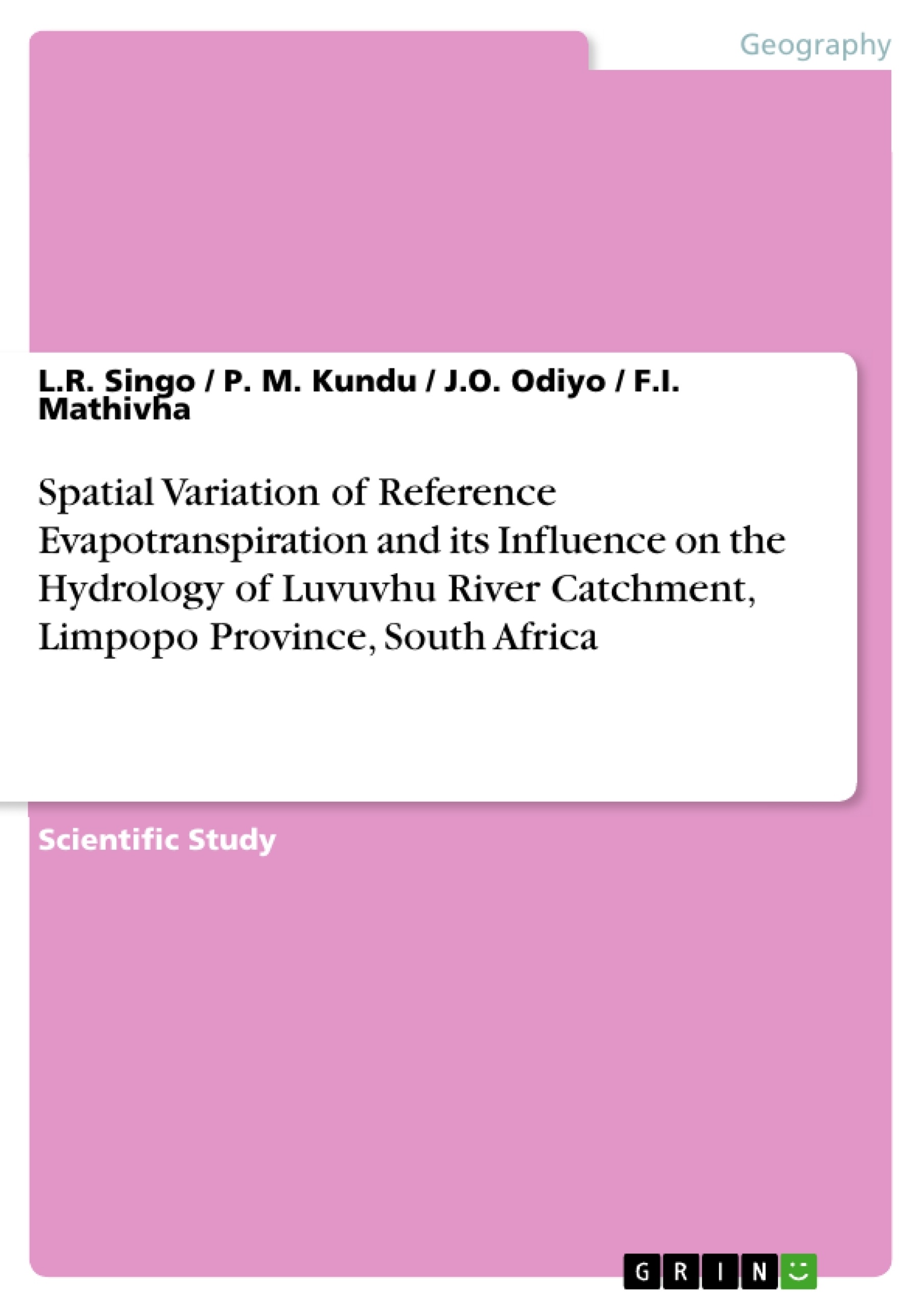Evapotranspiration (ET) is regarded as the largest mode of water loss in arid and semi-arid areas and is critical for accurate predictions of water exchange and crop productivity. Analysis of spatial and temporal fluctuations of evapotranspiration is therefore crucial to understand the coupled water and energy cycles in arid and semi-arid environments.
This study estimated reference evapotranspiration (ETo) to study its influence on the hydrology of Luvuvhu River Catchment using a physically based model. The ETo plays a key role in irrigation systems design, water management under irrigated and rainfed production. The Penman-Monteith equation which is widely used in water resource management and planning was used to estimate ETo. Simulation of ETo was performed using CROPWAT 8.0 software. This algorithm is useful in simulating water resource management scenarios at different spatial and temporal scales under a wide range of environmental conditions. To understand the impact of climatic characteristics in the formulation of evapotranspiration model, seasonal variation of different meteorological parameters such as wind speed, solar radiation, temperature and humidity was analysed. Results showed the spatial and temporal distribution of ETo for different climatic stations in the study area with peaks in summer months. Minimum values of ETo were observed during the dry months. Results from the simulations showed that the areas with higher ETo values were near rivers and streams, which generally have more abundant vegetation. Areas with low ETo values were relatively dry, where pasture and grasslands dominated the landscape. Correlation results showed that no relationship exists between stream flow and ETo (r = 0.36) in the study area, hence, a significant relationship exists between rainfall and ETo (r = 0.86). The study recommends the use of CROPWAT model for computing ETo under arid and semi-arid climatic conditions for water resource management and planning.
Inhaltsverzeichnis (Table of Contents)
- Abstract
- 1. Introduction
- 2. The Study Area
- 3. Material and Methods
- 3.1 Hydrometeorological Data
- 3.2 Evapotranspiration Analysis
- 3.3 Statistical Analysis
- 4. Results
- 4.1 Hydrometeorological Analysis
- 4.2 Reference Evapotranspiration Analysis
- 4.3 Statistical Analysis
- 5. Conclusions
- References
Zielsetzung und Themenschwerpunkte (Objectives and Key Themes)
This study aimed to estimate reference evapotranspiration (ETo) and investigate its influence on the hydrology of the Luvuvhu River Catchment (LRC) in Limpopo Province, South Africa, using a physically-based model. The study explored the spatial and temporal variations of ETo in the LRC and its relationship with rainfall and streamflow. The main objective was to understand the role of ETo in the water balance of the catchment and its implications for water resource management.
- Spatial and temporal variations of reference evapotranspiration (ETo)
- Influence of ETo on the hydrology of the Luvuvhu River Catchment
- Relationship between ETo, rainfall, and streamflow
- Application of the Penman-Monteith equation and CROPWAT 8.0 model for ETo estimation
- Water resource management implications of ETo in semi-arid regions
Zusammenfassung der Kapitel (Chapter Summaries)
- Introduction: This chapter provides a comprehensive overview of evapotranspiration (ET) as a key component of the hydrological cycle, particularly in arid and semi-arid areas. It highlights the importance of understanding ET for sustainable water resource management and discusses the challenges associated with estimating ET, especially at the basin scale. The chapter introduces the Luvuvhu River Catchment (LRC) as a study area and emphasizes the need for accurate ET estimation in semi-arid regions like the LRC, where rainfall is limited and water resources are scarce.
- The Study Area: This chapter presents a detailed description of the LRC, including its geographical location, climate, topography, soils, and land use/cover. It discusses the LRC's semi-arid climate with two distinct seasons: a rainy season from October to April and a dry season from May to September. The chapter highlights the impact of the Intertropical Convergence Zone (ITCZ) and local orographic effects on the region's climate and rainfall patterns. Additionally, it describes the topographic features, soil types, and land use practices within the LRC, emphasizing the importance of understanding these factors for accurate ET estimation.
- Material and Methods: This chapter outlines the methodology employed in the study, including the data sources, evapotranspiration analysis techniques, and statistical methods used. It describes the hydrometeorological data used, focusing on meteorological parameters like wind speed, solar radiation, temperature, and humidity. The chapter explains the application of the Penman-Monteith equation and the CROPWAT 8.0 software for estimating reference evapotranspiration (ETo). It also details the statistical analysis techniques used to analyze the relationship between ETo, rainfall, and streamflow.
Schlüsselwörter (Keywords)
The study focuses on the following key terms and concepts: reference evapotranspiration (ETo), Penman-Monteith equation, CROPWAT model, catchment hydrology, water resource management, semi-arid regions, climatic characteristics, and spatial and temporal variations. The study explores the influence of ETo on the water balance of the Luvuvhu River Catchment in South Africa, highlighting its implications for sustainable water management in arid and semi-arid environments.
- Quote paper
- L.R. Singo (Author), P. M. Kundu (Author), J.O. Odiyo (Author), F.I. Mathivha (Author), 2016, Spatial Variation of Reference Evapotranspiration and its Influence on the Hydrology of Luvuvhu River Catchment, Limpopo Province, South Africa, Munich, GRIN Verlag, https://www.grin.com/document/323712



